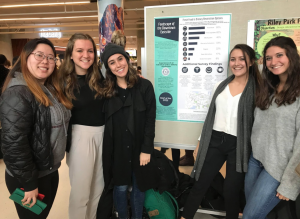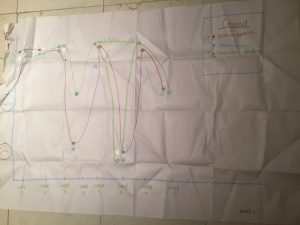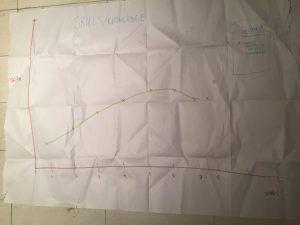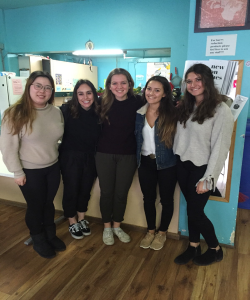We wonder how an asset-based development approach may affect the long-term growth of a program if critical feedback of possible program deficits are not prioritized.

Image 1: Group 11 members from left to right: Yuan, Mikaela, Emma, Keiten and Elena standing alongside their DTES Foodscape poster that was presented to LFS members, staff, and Vancouver community members on March 26, 2018.
Introduction
Past studies have indicated that there is a high prevalence of female targeted violence in co-ed homeless shelters (Duchesne, 2015). This issue has since been addressed and subsequently, women’s only shelters and programs have been developed. Although these facilities are a great stepping stone towards eradicating violence targeting women, they fail to address potential violence amongst women that could occur in these programs.
Throughout this course we have been taught to focus primarily on the assets of certain programs and build upon them, as opposed to focusing on program deficits (“Session 2 – Food Justice + Asset-Based Community Development”, n.d.). This way of analyzing programs is beneficial in many ways but may fail to evaluate the program in its entirety. In order for these programs to best meet the needs of the individuals they are serving, constructive feedback regarding program deficits is essential for program improvement. If we fail to acknowledge certain program deficits, these deficits will only worsen and thus the functionality of the program will be impaired.
What
A moment of significance occurred while we were surveying one of the women’s only food shelters. A woman approached us asking if we were government workers, as she wanted to express her concerns about the program and be apart of the conversation between program and government workers. It was evident that she felt excluded from conversations regarding how the program was being run. She voiced her fear regarding her personal safety in the program, as she mentioned that her personal items were often stolen. She also noted that there were daily fights amongst women who accessed the program.
So what
This conversation brings to light a larger issue regarding food security of homeless individuals. The definition of food security states that one must have access to SAFE and nutritious food (Hodson, 2017). In the aforementioned example, while the program did provide food of adequate quantity, individuals accessing the program didn’t feel safe which could affect the frequency of their usage of the program and in turn negatively impact their nutritional status. In order for a program to ensure that the individuals it serves are food secure, it must encompass ALL of the requirements that are set within the definition of food security, such as creating a violence-free atmosphere.
Now What
In our final report (that will be given to our community partner and Vancouver Coastal Health) we will make recommendations (based off of our project findings) of where we believe future funding could be allocated, in order to ensure food security for individuals accessing programs in the DTES. We suggest that government funding of food programs could consider allocating funds towards violence prevention training (for staff members), equipping staff with the necessary tools and behavioral strategies needed to diffuse fights and create a welcoming and safe environment.
Linkages
Historically women are at the greatest risk for familial and gendered violence (Browne & Bassuk, 1997) . As a result, female-only programs have been created in areas such as the DTES in an attempt to mitigate the prevalence of violence against women, as it is common for homeless women to experience physical violence (Duchesne, 2015 ). In a study done by D’Ercole & Struening the researchers found that 63% of respondents reported some type of violence from their adult partner (Browne & Bassuk, 1997) while more recently, a study conducted by the Women’s Coalition in the DTES found that 48% of women had experienced violence in the last two years (Women’s Coalition, 2014). Additionally, for females, binge drug-use and drug dealing were also positively correlated with violence (Marshall, Fairbairn & Wood, 2018). These findings further indicate the importance of prioritizing violence prevention in this population.
Next Steps
We suggest discussing our group’s findings from the survey with our community partner can help to determine how it can be distributed throughout the community, as it can be a valuable resource. One possible way to do this is by condensing our infographic into a brochure so that our survey results can be shared with the DTES community. This information will help DTES residents learn about the specific foods that DTES food programs offer, making it easier to locate where foods that are suited to their dietary needs are located.
Weekly Objectives
This week we hope to finish all course requirements for LFS 350. We have now completed our infographic presentation which was a great learning experience. We are grateful for the opportunity we were given to share our project findings with community partners as well as LFS staff and hear their feedback. This week our goal is to complete our final report. We will also contact our community partner and send her our final report. We hope to complete our final assignments for this course in a timely manner and dismount gracefully with as much ease as possible, in order to minimize the stress we are feeling regarding our upcoming final exams.
Achievements
- Finished the data analysis of our survey results.
- Completed the group infographic and presentation.
- Began working on our final report.
Limitations
A limitation of our project was that our findings do not represent the entire community as we only spoke with the Downtown Eastside food programs’ staff therefore only viewing this situation from their perspective. We did not speak directly to residents and as a result, there were viewpoints and opinions that were absent from the conversation. Our survey also only included 18 DTES food organizations, limiting our sample size. For future research on the Downtown Eastside regarding food programs and dietary restrictions, researchers should include input from residents as well and increase the sample size of food programs surveyed, in order to more accurately represent this community’s needs.
Future Advice
To future LFS 350 students: The way in which you will learn about food security and food justice in this course is incredibly unique because you often will experience it in a real life setting, so embrace it. At times, it will be unclear what your projects outcomes may be but trust the process. As the end of the term approaches, your findings will become evidently clear. Don’t be disappointed if your project outcomes don’t match up to the objectives set at the onset of your project, as this may mean you have brought to light concepts/findings that may have been previously overlooked! Lastly, be a team player, and do your fair share of the group work. At the onset of the term, make very clear expectations with your group of who will do what roles! Enjoy!
Conclusion
Upon reflecting on this experience, we see the immense value of asset-based community development. We believe that asset-based community development is an essential component when creating community food services and programs, however we believe that acknowledging program deficits and gaps is essential for a program to grow and be sustained in the long-term. We believe this is of the utmost importance as we experienced firsthand the daily fear of violence that individuals face when accessing programs that they rely upon for essential human needs.
References:
Browne, A., & Bassuk, S. S. (1997). Intimate violence in the lives of homeless
and poor housed women: Prevalence and patterns in an ethnically diverse sample. American Journal of Orthopsychiatry, 67(2), 261-278.
Duchesne, A. (2015). Women and Homelessness in Canada: A brief review of
the literature, 7-8. McGill University. Retrieved from https://www.mcgill.ca/socialdevelopment/files/socialdevelopment/women_in_homelessness_-_a_brief_report.pdf
Hodson, R. (2017). Food security. Nature, 544(7651), 5.
Marshall, B. D. L., Fairbairn, N., Li, K., Wood, E., & Kerr, T. (2008). Physical
violence among a prospective cohort of injection drug users: A gender-focused approach. Drug and Alcohol Dependence, 97(3), 237-246.
Session 2 – Food Justice + Asset-Based Community Development.
lfs350.landfood.ubc.ca. Retrieved 7 April 2018, from http://lfs350.landfood.ubc.ca/session-notes/term-1-session-notes/session-2/
Women’s Coalition. (2014). Getting to the roots: Exploring systemic violence
against women in the Downtown Eastside of Vancouver, 6. Retrieved from http://wish-vancouver.net/wp-content/uploads/2012/03/Getting-to-the-Roots-final-Nov-2-2014.pdf


